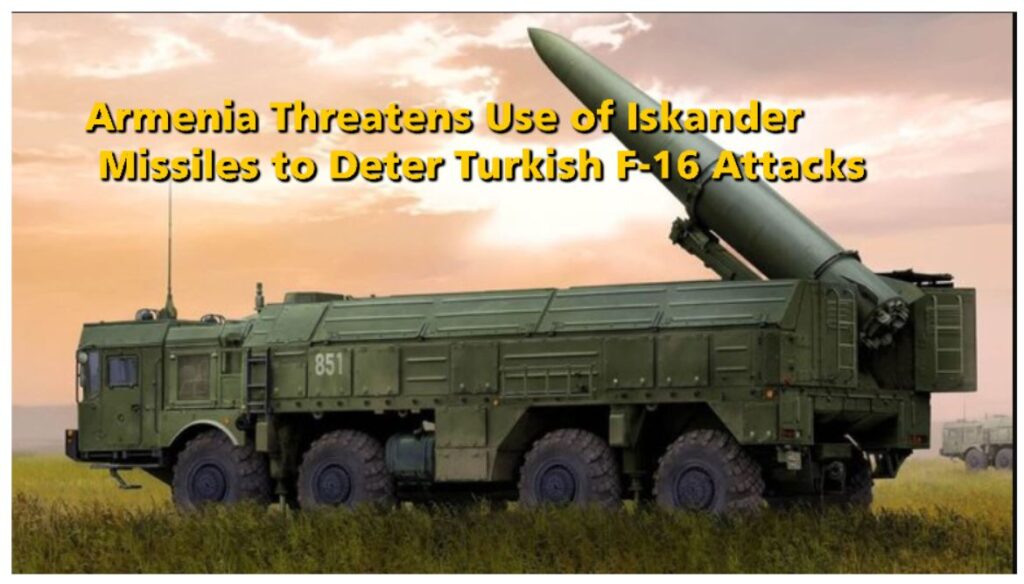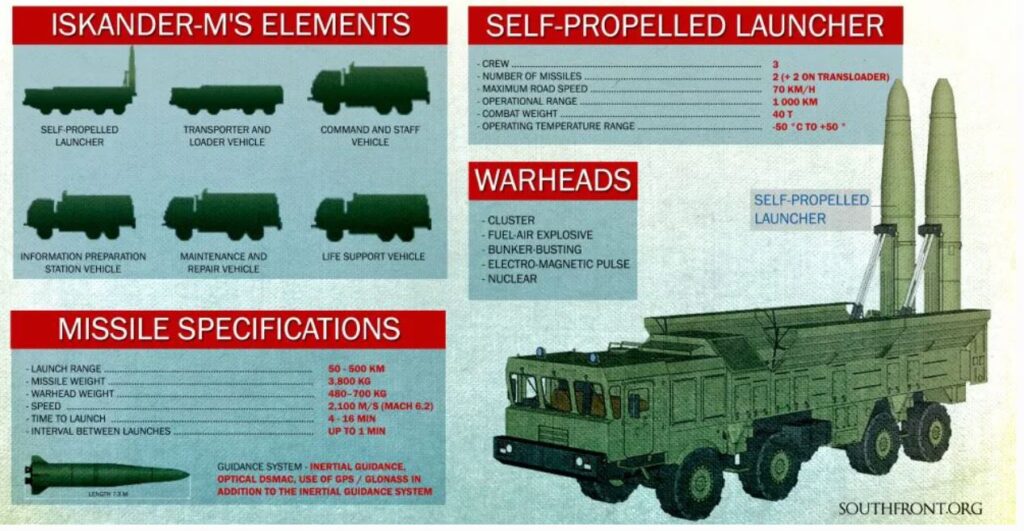
In theory the Iskander can be fitted with tactical nuclear weapons Amid ongoing clashes between Armenian and Azeri forces over control of the disputed Nagorno-Karabakh region, the latter party’s close defense partner Turkey has reportedly threatened to deploy American-supplied F-16 fighter jets against Armenian forces. This follows multiple reports that Turkey had dispatched Al Qaeda-linked jihadists to support Azeri forces against the Armenian Army, and could represent the third foreign military intervention by the NATO member state this year following major interventions against the Russian backed Syrian Arab Army and the Egyptian backed Libyan National Army. The Armenian government has referred to the threat of Turkish intervention a ‘Sword of Damocles’ hanging over the Nagorno-Karabakh region, with the country’s ambassador to Russia warning that the armed forces would counter any deployments of Turkish fighter jets with use of Iskander hypersonic ballistic missiles.

ADDITION INFORMATION
Iskander Video
Iskander Tactical Ballistic Missile System
The Iskander (Nato: SS-26 Stone) is a tactical ballistic missile system being manufactured by the Federal State Unitary
Type
Tactical ballistic missile system
Country Russia
Length 7.3m
Diameter 0.92m
Launching Rockets 3,800kg
Payload 480kg
Launcher with Rockets 42,300kg
Minimum Firing Range 50km
Maximum Firing Range 280km (Iskander-E)
Warhead Type Cassette, high-explosive fragmentation, penetration
Rocket SPR
Type of Control Self-contained, inertial, complex with an optical homing
Engine Single-stage solid-propellant

Iskander-E export ballistic missile system
The Iskander missile system is produced in three variants. Iskander-E is an export version designed to meet the guidelines of MTCR (missile technology control regime). It has a maximum firing range of 280km and circular error probable (CEP) of 30m to 70m. It is also equipped with an inertial guidance system.
Iskande-M extended-range missile system
Iskander-M is an extended range missile developed for the Russian Army. The missile has an expected range of more than 400km. It is equipped with inertial and optical guidance systems for improved firing accuracy, and an electro-optical seeker for self-homing capabilities.
Iskander-K cruise missile system
Iskander-K is the latest variant in the Iskander series of missiles. The missile system is equipped with R-500 cruise missile. It was first test fired from the mobile Iskander platform in May 2007. It attained a speed of approximately 250m a second at altitudes of 100m.
Iskander missile system features
The Iskander missile system is equipped with two independently targeted short-range ballistic missiles. Each missile has a length of 7.3m, body diameter of 0.92m and weight of 3,800kg. The missile can be re-targeted during flight to engage moving targets.
Iskander can carry 480kg of conventional warheads including HE fragmentation, submunition, penetration, fuel-air explosive and electro-magnetic pulse. The minimum firing range of the missile is 50km and the maximum is 280km. Iskander is powered by a single-stage solid-propellant engine.
The Iskander-M is equipped with a self-contained inertial navigation system (INS) and an optically guided warhead. The optical homing head can also be controlled from an airborne warning and control system (AWACS) or an unmanned aerial vehicle (UAV). This feature provides a self-homing capability to the missile. Targets can be identified by satellite, aircraft, conventional intelligence centre or a soldier. After receiving the images of the target, the onboard computer of the missile locks onto the target with its sight and directs the warhead towards the target at supersonic speed.
The missile can overcome enemy air defense systems while offering high-probability of failure-free operation in countermeasures environments. It has a target accuracy of 5m to 7m and operates even in fog or low visibility.
Launch vehicle for the tactical ballistic missile system
The transport-erector-launcher (TEL) vehicle based on the MZKT-7930 Astrolog 8×8 chassis carries two Iskander missiles.
“Iskander-K is the latest variant in the Iskander series of missiles.”
The TEL is powered by a YaMZ-846 diesel engine delivering a power output of 500hp. The vehicle is equipped with full nuclear, biological and chemical (NBC) protection systems. Four hydraulic jack supports on the vehicle enable the positioning of the TEL on uneven land within a short time. Missiles are raised to an angle of 85°, which takes around 20 seconds. The vehicle can be transported by an Antonov An-124 transport aircraft.
The Iskander TEL is supported by a transporter and loader vehicle built on the same 8×8 chassis. The vehicle can carry two reload missiles and a crane. The full Iskander missile system also comprises a command and control post vehicle, mission planning vehicle, maintenance and repair vehicle and a life support vehicle. These vehicles are based on KamAZ 43101 6×6 cargo truck chassis.
The missile can be equipped with various combat units (10 types in total), including:
a cluster warhead with shrapnel-type non-contact detonation warheads;
a cluster munition with cumulative shrapnel warheads;
a cluster munition with self-manufacturing warheads; a cluster munition with self-manufacturing warheads;
a cluster munition with a volume detonation capability;
shrapnel-flagged warhead (SRFF);
high-explosive high-explosive warhead;
penetrating combat unit (IBU).
The complex consists of:
9P78 self-propelled launcher (SPS);
transport and charging machine 9T250 (TZM);
command and staff vehicle 9C552 (KShM);
mobile information preparation station 9C920 (PPI);
Regulation and Maintenance Machine (MRTO);
sets of arsenal and training equipment.
The 9M723 is a solid fuel, single-stage missile with a head part not separated in flight. The missile is controlled on the entire flight path by means of aerodynamic and gas-dynamic rudders. The flight path of 9M723 is not ballistic but controllable. The missile constantly changes the plane of the trajectory. It is particularly active in maneuvering at its acceleration and approach to the target – with an overload of 20 to 30g. In order to intercept the 9M723 missile, the missile must move along a trajectory with an overload two to three times higher, which is almost impossible. Most of the missile’s trajectory, manufactured using Stealth technology and having a small reflective surface, passes at an altitude of 50 km, which also significantly reduces the probability of its defeat by the enemy. The ‘invisibility’ effect is achieved by combining the missile’s design features with special coatings.
The missile is brought directly to its target by an inertial control system and then captured by an autonomous correlation-extreme homing optical head (see photo). The principle of operation of the homing system OTR 9M723 is that the optical equipment generates an image of the terrain in the target area, which is compared by the on-board computer with the standard introduced during the preparation of the missile for launch. The optical head is highly resistant to existing means of electronic warfare and allows successful missile launches even on moonless nights when there is no additional natural illumination of the target, hitting the target with an accuracy of plus or minus two meters. No other tactical system in the world can accomplish such a task except Iskander. In addition, optical systems do not need signals from space radio navigation systems, which can be switched off or disabled by radio interference in crisis cases. Combining inertial control with satellite navigation equipment and optical CNS makes it possible to create a missile that hits a given target in almost every conceivable condition. The homing head can also be used on ballistic and cruise missiles of various classes and types.




